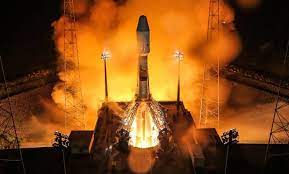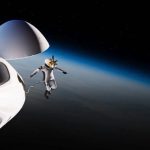Due to the Soyuz Embargo of Russian Sanctions Many Satellites Dont Have Launch Options Available
More than a dozen former Soyuz satellite missions scrapped need new rides after Russia’s invasion of Ukraine, raising questions over how fast the launch market can absorb the loss of the workhorse rocket.
While Russia’s share of the international launch market has shrunk, the Soyuz rocket’s sudden exit from the global stage has left more than a dozen non-Russian satellite missions without clear paths to orbit.
 Phil Smith, a BryceTech analyst who follows the commercial launch industry, said the sudden, indefinite removal of Soyuz from the market “puts some customers in a lurch.” And while “options exist” thanks to “new capability being introduced” this year by Arianespace and others, “prompt rescheduling will be challenging as these companies have existing backlogs.”
Phil Smith, a BryceTech analyst who follows the commercial launch industry, said the sudden, indefinite removal of Soyuz from the market “puts some customers in a lurch.” And while “options exist” thanks to “new capability being introduced” this year by Arianespace and others, “prompt rescheduling will be challenging as these companies have existing backlogs.”
The European Union counted on at least six Soyuz rockets this year and beyond to launch a mix of navigation, Earth observation, and science satellites from France’s South American spaceport. Smaller rideshare customers from Japan to Sweden say they may need new accommodations. And a South Korean imaging satellite is at Russia’s Baikonur Cosmodrome awaiting a launch that’s now in question.
But it’s London-based OneWeb that has the biggest scheduling headache without Soyuz. The low Earth orbit broadband startup, which bought all but two of the 10 missions that Soyuz flew for non-Russian customers in 2021, planned to deploy its final six batches of satellites by the middle of this year using the Russian rocket.
OneWeb’s latest batch of 36 satellites had been poised to lift off from Russia’s Baikonur Cosmodrome on March 4 before Russia imposed poison-pill conditions on the launch. OneWeb subsequently suspended all further Soyuz missions.
Russia’s Proton rocket, once a staple for commercial satellite launches, is likewise off-limits as Western nations continue to tighten sanctions.
Stranded payloads
Some of the missions that were counting on Soyuz launches in 2022 or 2023 include:
- Two pairs of satellites for Europe’s Galileo navigation constellation
- ESA’s Euclid infrared space telescope and EarthCARE satellite
- The Sentinel 1C radar satellite for Europe’s Copernicus Earth-observation program
- The Swedish National Space Agency-funded MATS microsatellite for measuring gases in Earth’s atmosphere
- Four GRUS remote sensing microsatellites for Japanese Earth imagery operator Axelspace
- The StriX-1 demonstration satellite for Synspective, a Japanese synthetic aperture radar (SAR) company
ESA spokesperson Ninja Menning said Europe is “currently looking at the alternatives and the roadmap” for launching Galileo, Euclid and EarthCARE satellites without Soyuz. The missions will be discussed at an ESA Council meeting on March 16, with updated statuses announced on March 17. Menning said it will “take a bit longer than that” to commit to next steps, “but at least we’ll [give] the variety of scenarios that are possible.”
She said ESA is “currently identifying everything that’s affected” by the “geopolitical impact on space programs … we’re not done yet.”
Swedish National Space Agency Director General Anna Rathsman said March 8 that the agency is “looking for other options outside Russia” for launching the Mesospheric Airglow/Aerosol Tomography and Spectroscopy, or MATS, satellite.
Axelspace spokesperson Mei Ikumoto said March 9 Tokyo-based company is “closely monitoring the current situation and considering all possibilities” for the four GRUS satellites slated for a Soyuz later this year.
EUMETSAT, Europe’s meteorological satellite agency, had planned to launch the first Metop-SG weather satellite with Soyuz from French Guiana in 2024. Two additional Metop satellites currently slated for 2025 and 2031 were penciled in for a combination of Soyuz and Ariane 6 launches. “We are currently assessing the situation with Arianespace and cannot say more at the moment,” said Paul Counet, EUMETSAT’s head of strategy, communication and international relations.
No single launch provider appears to have the available capacity to deploy OneWeb’s remaining satellites in the short-term, according to Gunter Krebs, a spaceflight historian and software engineer who created Gunter’s Space Page in 1996 to track satellite and launch activity.
Three otherwise suitable flagship rockets — Arianespace’s Ariane 5, Mitsubishi Heavy Industries’ H-2A, and United Launch Alliance’s Atlas 5 — are being phased out, with no room left on their manifests. India’s GSLV rocket, while large enough to pick up some of the Soyuz slack, has not demonstrated a high flight rate, Krebs said, making near-term availability unlikely.
China’s Long March family of rockets, meanwhile, is off-limits to OneWeb’s American-made satellites and most if not all of the other stranded Soyuz payloads due to export-control restrictions on spacecraft with U.S. parts.
“This leaves only Falcon 9 for short-term launches,” Krebs said. “But I am not sure [OneWeb’s] demand can be met at all in the next 12-18 months if OneWeb and SpaceX can not agree to launches.”
OneWeb says it’s weighing all its options, starting with Arianespace, which is on the hook for the six Soyuz launches. “We’re looking at U.S., Japanese and Indian options,” Chris McLaughlin, OneWeb’s chief of government, regulatory affairs and engagement, said March 3. “But in the first instance, we’re pointing to Ariane and saying you still owe us a number of launches.”
“Arianespace is in close contact with its customers and French and European authorities to best assess all the consequences of this situation and develop alternative solutions,” Arianespace said in a March 4 statement, declining further comment.
SpaceX in the frame
“The launch industry is in a state of major transition, making it very difficult to absorb near-term demand,” Quilty Analytics senior analyst Caleb Henry said.
“With the exception of SpaceX, all of the world’s heavy-lift launch providers are retiring their flagship vehicles,” he said. “That means manufacturing of trusted and true rockets is slowing to a halt while new vehicles are just beginning to ramp production.”
Additionally, new launch vehicles always take longer than expected to debut and settle into a flight rhythm, Henry said, meaning “launch rates will be low for many vehicles in the coming years.”
The industry is still waiting for Arianespace’s Ariane 6, ULA’s Vulcan and Mitsubishi Heavy Industries’ H3 next-generation rockets, and Blue Origin’s New Glenn to make their maiden flights following delays.
As Russia was massing troops near Ukraine in December under the pretense of military exercises, satellite executives gathered in Paris for Euroconsult’s annual World Satellite Business Week conference noted the potential for schedule pressure and geopolitics to create a bottleneck. “If I was a commercial satellite operator, I’d be very concerned, and we are hearing those concerns,” said Tiphaine Louradour, president of International Launch Services, a U.S.-based company that markets Proton and Soyuz.
Like Krebs and others, Henry noted that SpaceX is the only launch provider outside of China with an operational, high-cadence, heavy-launch capability that is not fully booked or winding down production.
SpaceX, Henry said, would be “an undesirable choice for OneWeb.”
Even though SpaceX’s Starlink broadband constellation is principally geared toward consumers, and OneWeb toward enterprises, he said the two still compete for government customers “and risk greater competition as they flesh out different services.”
SpaceX did not respond to requests for comment.
Claude Rousseau, a consultant for Northern Sky Research, also sees “very little room to absorb a higher cadence of launch for Soyuz-class capacity” as “most of the current launch vehicles are fully manifested for the next 24 to 36 months.”
However, Rousseau believes this also offers “opportunities for those who wanted to rise to the occasion,” pointing to multiple emerging small satellite launchers that are working toward launching at a regular cadence.
“These unproven vehicles are making many potential customers uneasy, but they will eventually help unclog the launch bottleneck,” Rousseau said.
Relativity Space’s Terran 1, Firefly’s Alpha and ABL’s RS1 are all advertising capabilities to send 1,000-kilograms or more to low Earth orbit.
However, Quilty Analytics estimates the largest of the emerging small launch vehicles will only have the ability to carry four to six 150-kilogram OneWeb satellites per rocket, factoring in satellite mass, orbital inclination and typical separation altitude.
“This means it would take anywhere from four to nine times as many launches just to fill the gap from one Soyuz, which is no doubt a more expensive proposition,” Henry said.
New vehicles would also likely require new payload adaptors and related equipment that an industry source said could take at least several months to qualify.
BryceTech’s Smith said the launch industry remains resilient, despite delays to qualify new launch vehicles, and does not think the loss of Soyuz will be much of an issue for the sector, “in particular because Russia commercial [launch] activity is basically nil.”
“In general, the industry is resilient, there are options for payload, adapters — the launch providers like SpaceX and others [have] different options available for precisely this kind of thing to attract customers,” Smith said.
He added: “Part of the resiliency is the ability to respond quickly — SpaceX, in particular, has been notable for that.”
Sidelined Soyuz
Roscosmos Director General Dmitry Rogozin, who said last week that the United States would be reduced to flying “broomsticks” to space without Russian engines,
said March 8 that the rockets booked for OneWeb will instead be offered “practically free” to private Russian space companies.
“By the end of the year, dozens of private Russian spacecraft for communication, meteorological observation, and remote sensing of the Earth will be sent into orbit,” Rogozin tweeted. “For this, Soyuz-2 carrier rockets, which we have derived from the launch project of the British OneWeb satellite system, will be used.”
Soyuz flew 21 missions last year, 11 of which were Russian government payloads. Nearly all the rest of Soyuz’s payloads came from abroad, including a Soyuz commercial rideshare mission carrying 38 satellites from 18 countries.
There are few private Russian space companies to take Rogozin up on the offer. Dauria Aerospace, the first Russian space startup, is no longer in business. That leaves a handful of Moscow-based startups like Orbital Express, Avant Space, and Sputnix.
It is unclear if these or any other private Russian company could be ready to launch satellites in the timeframe Rogozin mentioned.
“There does not appear to be anything remotely close to enough commercial Russian demand to fill six Soyuz rockets anytime soon, even at rock-bottom prices,” Henry said.
Anatoly Zak of RussianSpaceWeb.com agreed. “I am not aware of any “private” company in Russia that have launched anything substantial up to this point,” he said by email. “There are some university departments trying to build nano-satellites. Possibly, [Rogozin] refers to the Smotr series of remote-sensing satellites promised by Gazprom/Gazkom venture, but I am not sure what is the real status of this project right now.”
Editor Note: It seems the Russia-Ukraine conflict has a significant space dimension and the Space Race between USA and Russia can be livening up again.




































Add Comment